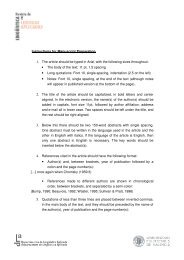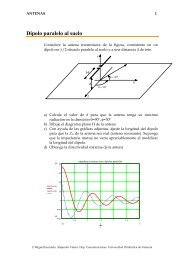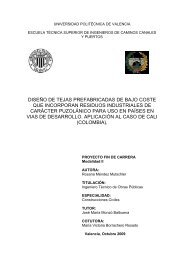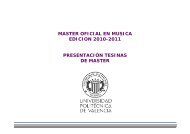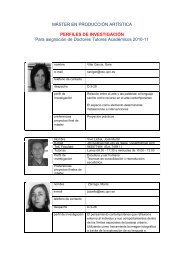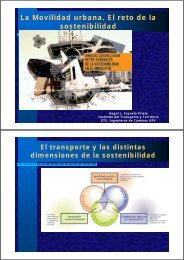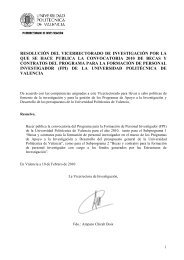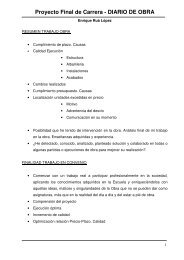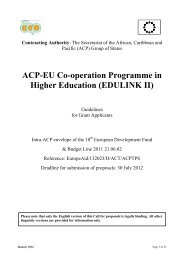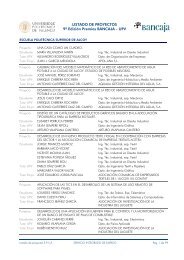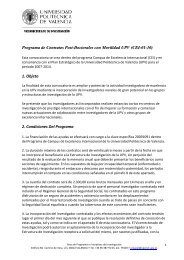CulturAl DomAINS: trANSlAtIoN ProblEmS
CulturAl DomAINS: trANSlAtIoN ProblEmS
CulturAl DomAINS: trANSlAtIoN ProblEmS
Create successful ePaper yourself
Turn your PDF publications into a flip-book with our unique Google optimized e-Paper software.
<strong>CulturAl</strong> <strong>DomAINS</strong>: <strong>trANSlAtIoN</strong> <strong>ProblEmS</strong><br />
volumen 4 año 2009<br />
Abstract: Much of the lexis of a language has a cultural referent and is thus specific to a speech community.<br />
The meaning of culturally marked words is often difficult to grasp without some cultural knowledge and poses<br />
translation problems, particularly when the words are associated with cultural domains (Nida, 2001). In the<br />
present paper we focus on the French cultural domain of cooking. After outlining the elements of the domain,<br />
we analyse the difficulties in translating the lexical units from the domain and the range of translation procedures<br />
which try to account for their meaning.<br />
Key words: cultural word, cultural domain, metaphorical meaning, translation procedures, source language,<br />
target language.<br />
1. INTRODUCTION<br />
Isabel Negro Alousque<br />
Universidad Complutense<br />
Recent research has shown the cultural component of many lexical units (Inchaurralde, 2003;<br />
Niemeier, 2004; Wierzbicka, 1998, 2008). For instance, Wierzbicka (2008: 7) points out that “the<br />
meaning of words provide the best evidence for the reality of cultures as ways of speaking, thinking<br />
and living.”<br />
The translation of culturally marked words is a problematic issue that has been explored by a<br />
number of authors (Inchaurralde, 2003; Newmark, 1988, 1991). A range of translation procedures<br />
have been suggested to transfer the cultural information encoded by the SL vocabulary to the TL.<br />
We provide an overview of these translation procedures in Table 1 and we illustrate them through<br />
various French domains.<br />
Translation strategy Definition Example<br />
Cultural equivalent The SL cultural word is translated<br />
by a TL cultural word<br />
Functional<br />
equivalent<br />
Descriptive<br />
equivalent<br />
The SL cultural word is translated<br />
by a TL culture-free word<br />
The SL cultural word is replaced by<br />
a description of the word in the TL<br />
Domestication The SL cultural word is adapted to<br />
the target culture<br />
Exotization/<br />
Foreignization<br />
Table 1. Translation procedures for cultural words.<br />
The SL cultural word keeps its<br />
graphic or morphological form to<br />
make it closer to the source culture<br />
les sans-abri ➔ the homeless<br />
logement social ➔ state-subsidized housing<br />
baccalauréat ➔ French secondary school<br />
leaving exam<br />
civet ➔ stewed rabbit<br />
pause-café ➔ tea-break<br />
punch (drink)<br />
Revista de Lingüística y Lenguas Aplicadas | 137
volumen 4 año 2009<br />
The meaning of culturally dependent words is difficult to transfer in another language, particularly<br />
when the words are linked to cultural domains (Nida 2001: 21), i.e. important sets within a<br />
culture. One of such sets is cooking, which is related to time, place, what and how.<br />
In order to illustrate the translation problems posed by the lexis pertaining to cultural domains,<br />
we have chosen to examine the cultural domain of cooking in the French language, whose elements<br />
are the following:<br />
- Participants: cuisinier, cuistot (cook), aide cuisinier (kitchen porter), chef.<br />
- Event: actions (cuisiner, faire cuire / mijoter / bouillir, beurrer, gratiner ...) and objects (food<br />
and dishes).<br />
- Place: cuisine (kitchen).<br />
In the sections below, we look closely at the implications of cultural lexis for translation and at<br />
the translation strategies that try to account for the meaning of the words from cultural domains.<br />
2. IMPLICATIONS OF CULTURAL DOMAINS FOR TRANSLATION<br />
Words encoding cultural information are difficult to translate since they involve cultural<br />
knowledge and a cultural background. Literal translation may not fully render the meaning of<br />
culture bound words because they do not have the same semantic range in the source and the<br />
target languages. Let us take the case of pain / bread, a transcultural word (Newmark 1991:8),<br />
i.e. a word with similar referents and different connotations in different languages. Both pain and<br />
bread describe the staple made from flour, and yet within their separate cultural context they<br />
do not signify the same. In France pain is found in various sizes and shapes (baguette, ficelle,<br />
flûte ...) and is a cultural symbol, as shows its strong association with the prototypical image of a<br />
French person - a man wearing a beret with a long loaf (baguette) in his hands. In Britain bread<br />
is normally French bread and is not often eaten in meals. Therefore, there is a distinction both<br />
between the objects referred to by cultural words and between the function and value of these<br />
objects in their cultural context (Bassnett 1991: 19).<br />
The problems found in transferring the meaning of cultural words to the target language can<br />
be summarised as follows:<br />
1. The concept expressed by the source language (hence SL) word does not exist in the target<br />
language (hence TL). Three types of words from the French cultural domain of cooking fall<br />
in this category :<br />
1.1. Words describing foods such as petit beurre, petit four, or ways of cooking, e.g. gratiné.<br />
Note that petit beurre and petit four are metonymies (part-for the whole and place-for-product<br />
metonymies respectively). It is worth mentioning the wealth of words describing different kinds<br />
of bread (flûte, baguette, miche, ficelle) and of metaphorical expressions containing the lexical<br />
item pain (manger son pain blanc le premier).<br />
1.2. Words for French dishes, e.g. quiche, crêpe. This group includes the bulk of the terms for<br />
meat dishes (pot-au-feu, tripous, blanquette), and many kinds of confectionery, e.g. nougat,<br />
frangipane, massepain, macaron.<br />
138 | Revista de Lingüística y Lenguas Aplicadas
volumen 4 año 2009<br />
In these cases, either a lexical gap is found in the TL, or a translation strategy such as a loan<br />
or a descriptive equivalent is used. In loans, the SL word is preserved in the TL with the same or<br />
a similar phonetic and graphic form, e.g. fricassée (French) / fricassee (English). In Newmark’s<br />
words (1988: 82), fricassee is an example of naturalisation, i.e. adaptation of the SL item to the<br />
pronunciation and morphology of the TL.<br />
Some examples are provided in table 2.<br />
French word English word Translation procedure<br />
quiche ______ _____ (Lexical gap)<br />
quenelle<br />
confit<br />
pot-au-feu<br />
tripous<br />
blanquette<br />
petit beurre/petit four<br />
civet<br />
quenelle<br />
confit<br />
boiled beef with vegetables<br />
dish made of sheep’s offal<br />
veal in a white sauce<br />
a kind of butter biscuit<br />
stewed rabbit<br />
Table 2. Techniques to translate SL cultural words with no equivalent in the TL.<br />
Note that the most common translation technique is the descriptive equivalent, which is an<br />
explanation of the cultural term, thus facilitating foreign readers’ comprehension.<br />
2. The SL word is diaphasically marked. For instance, patate and bricheton are colloquial<br />
words for potato and bread, respectively.<br />
3. The other kind of translation problems we encounter when dealing with cultural lexis are<br />
the result of the metaphorical transfer of many of the lexical units from a cultural domain. The<br />
metaphorical transfer from the source domain onto various target domains operates across<br />
the French cultural domain of cooking. Some examples are shown in table 3.<br />
Loan<br />
descriptive equivalent<br />
Information French word/expression Referential meaning Figurative meaning<br />
Event cuisine<br />
cuire<br />
éplucher<br />
cook<br />
cook<br />
peel<br />
to scheme<br />
c’est du tout cuit ➔ it’ll be a<br />
walkover<br />
il est cuit ➔ he’s done for<br />
dissect<br />
Participants c’est la surprise du chef it’s the chef’s surprise unexpected event<br />
Place cuisine kitchen tricks<br />
Table 3. Metaphorical transfers in the French cultural domain of cooking.<br />
Revista de Lingüística y Lenguas Aplicadas | 139
volumen 4 año 2009<br />
In the French domain of cooking, the words encoding different kinds of information have a<br />
metaphorical meaning. The metaphorical meaning concerns the action (cuisiner “cook” ➔ to<br />
scheme), the participants (the chef’s surprise signifies an unexpected event) and the place (cuisine<br />
“kitchen” ➔ tricks).<br />
In our analysis of the metaphorical expressions drawing on the French cultural domain of<br />
cooking we found a range of translation phenomena. These phenomena and the translation techniques<br />
used to account for them are outlined in table 4.<br />
Translation phenomenon Translation procedure Example<br />
Identical metaphorical expressions<br />
in SL and TL<br />
Metaphorical expressions drawing<br />
on the same source domain in SL<br />
and TL<br />
Metaphorical expressions drawing<br />
on the same source domain in SL<br />
and TL with a different focus<br />
Metaphorical expressions drawing<br />
on different source domains in SL<br />
and TL<br />
Metaphorical expressions drawing<br />
on different source domains in SL<br />
and TL with a different realization<br />
No metaphorical counterpart in TL Descriptive equivalent<br />
Standard language equivalent<br />
Let us now look closely at these translation phenomena and procedures and provide further<br />
examples.<br />
1. The metaphorical expressions in the source and target languages are in perfect translation<br />
equivalence. A literal translation is provided. Consider the following examples:<br />
mijoter ➔ cook up<br />
c’est un gros poisson ➔ he’s a big fish<br />
140 | Revista de Lingüística y Lenguas Aplicadas<br />
Literal translation c’est un porc ➔ he’s a pig /<br />
a swine<br />
beurrer qq’un ➔ butter<br />
sb up<br />
Approximate equivalence c’est du nougat ➔ it’s a<br />
piece of cake<br />
Approximate equivalence mettre les petits plats dans<br />
les grands ➔ go to town<br />
on the meal<br />
Approximate equivalence donner de la confiture aux<br />
cochons ➔ throw pearls<br />
before swine<br />
Approximate equivalence faire ses choux gras ➔<br />
cash in on sth<br />
Table 4. Translation phenomena concerning cultural lexical units with a metaphorical meaning.<br />
se manger/se ronger les<br />
foies ➔ worry a lot<br />
les nougats ➔ one’s feet
la politique de la carotte ➔ the carrot and stick policy<br />
crème ➔ the cream of the crop<br />
volumen 4 año 2009<br />
Note that literal translation ranging from phrase to phrase through sentence to sentence. In<br />
the last example the English metaphorical expression has more force than its French counterpart.<br />
2. Both the SL and the TL expressions reflect a metaphorical mapping from the same source<br />
domain. The French and English expressions hinge upon the domain of cooking.<br />
The following are just a few examples:<br />
galette (a kind of cake) ➔ dough (money)<br />
omelette norvégienne ➔ baked Alaska<br />
gagner son bifteck ➔ earn one’s crust / one’s bread and butter<br />
As we see, in the translation process the SL metaphorical term or idiom is replaced by a TL<br />
metaphorical expression or idiom that serves the same purpose in the TL. This procedure is<br />
known as “approximate equivalence” (Newmark 1988: 90).<br />
Compare the SL and TL lexical units in the last example. The reference to the domain of cooking<br />
in made by a food item in the SL (omelette), while it is made by a cooking verb (baked) in the<br />
TL. Further, both expressions contain a geographical word: norvégienne (Norwegian) in French<br />
and Alaska in English.<br />
3. The SL and TL metaphorical expressions belong to the same source domain, but reflect a<br />
different focus in the conceptualization of reality. The meaning of the SL expression is conveyed<br />
by an approximate equivalent in the TL. The examples in table 5 illustrate this point (the focus is<br />
on the words underlined):<br />
Metaphorical expression Focus in French Focus in English<br />
mettre les petits plats dans les grands /<br />
go to town on the meal<br />
être cuit ➔ his goose is cooked<br />
course<br />
As we see, the French and English metaphorical expressions focus on different elements of<br />
the cultural domain: the action, the object (food/course/meal) or the place.<br />
meal<br />
action Food<br />
avoir du pain sur la planche ➔ have a<br />
lot on our plate<br />
food place<br />
Table 5. Metaphorical expressions with a different focus in the SL and TL.<br />
Revista de Lingüística y Lenguas Aplicadas | 141
volumen 4 año 2009<br />
4. The source language metaphorical expression has a counterpart in the target language, but<br />
the target expression is not a metaphorical mapping from the same source domain. The meaning<br />
of the French cooking idiom is conveyed in English by an approximate equivalent.<br />
The following French expressions illustrate this point:<br />
pour une bouchée de pain ➔ for a song<br />
marcher sur des oeufs ➔ skate on thin ice<br />
ménager la chèvre et le chou ➔ sit on the fence<br />
donner de la confiture aux cochons ➔ throw pearls before swine<br />
tirer les marrons du feu ➔ be a cat’s paw<br />
ce ne sont pas mes oignons ➔ that’s not my pigeon<br />
retourner quelqu’un comme une crêpe ➔ twist someone round your little finger<br />
cuisine quelqu’un ➔ give somebody the third degree<br />
garder une poire pour la soif ➔ save money for a rainy day<br />
5. The SL and TL metaphorical expressions draw on different source domains and have different<br />
linguistic realizations: a lexical unit (an idiom) in French and a grammatical unit – a phrasal<br />
verb – in English.<br />
Look at the following examples:<br />
faire ses choux gras ➔ cash in on something<br />
poireauter / faire le poireau ➔ hang about<br />
6. There is not a TL metaphorical counterpart of the SL metaphorical expression. This can be<br />
accounted for on the following grounds:<br />
6.1. The concept expressed by the SL metaphorical expression is non-existent in the TL, so<br />
that there is a lexical gap. Some examples are promettre plus de beurre que de pain (to make<br />
more promises than you will be able to keep) and cuisiner (to scheme).<br />
6.2. The SL lexical items are idiomatic in a colloquial register. For instance, the words denoting<br />
parts of the body: chou (cabbage) / poire ➔ head, nougats (a sweet food) feet, patate<br />
(potato) ➔ head, face<br />
The English counterpart is the standard English body word.<br />
142 | Revista de Lingüística y Lenguas Aplicadas
volumen 4 año 2009<br />
6.3. The concept expressed by the SL metaphorical word or expression exists in the TL but<br />
it is not expressed metaphorically. Instead a descriptive equivalent is provided in the TL. The<br />
descriptive equivalent is useful in that it transports the target language speakers into the original<br />
cultural context.<br />
bûche ➔ silly / apathic person<br />
dinde ➔ stupid person<br />
moule ➔ idiot, twit<br />
canard ➔ sugar lump dipped in brandy / coffee<br />
noix ➔ knob of butter<br />
marron ➔ blow<br />
un fromage ➔ a good job<br />
mettre une queue de morue ➔ put on a tailcoat<br />
compter pour du beurre ➔ not to count<br />
filer une prune ➔ give a cloat<br />
c’est de la bouillie pour les chats / manger de la bouillie ➔ it’s gibberish<br />
manger de la bouillie / avoir de la bouillie dans la bouche ➔ speak unclearly, mumble<br />
entre la poire et le fromage ➔ casually over lunch/dinner<br />
avoir la pêche ➔ be on form<br />
c’est la fin des haricots / les carottes sont cuites ➔ it’s all up / over<br />
un pousse-café ➔ a liqueur<br />
être chocolat ➔ be thwarted / foiled<br />
pour des prunes ➔ for nothing<br />
faire son beurre de quelque chose ➔ make a profit out of soemthing<br />
sucrer les fraises ➔ be a bit doddery<br />
la moutarde lui monte au nez to lose one’s temper<br />
éplucher / décortiquer ➔ dissect<br />
courir après le bifteck ➔ make a living<br />
c’est pas du nougat / du gateau / de la nougatine / de la tarte ➔ it’s not so easy<br />
Revista de Lingüística y Lenguas Aplicadas | 143
volumen 4 año 2009<br />
être dans les choux ➔ be in an embarrassing situation<br />
aller planter ses choux ➔ move to the countryside<br />
faire l’andouille / le veau ➔ act the fool<br />
tirer une/des carotte(s) de quelqu’un / carotter quelqu’un ➔ fiddle someone<br />
en avoir gros sur la patate ➔ be upset<br />
The content meaning of the idiom is sometimes loosely reproduced. Three types of meaning<br />
are lost: a) idiomatic meaning; b)connotative meaning, and c) pragmatic meaning.<br />
a)As advanced above, the loss of idiomatic meaning is a most relevant factor in the lexis from<br />
the French cultural domain of cooking. When SL idioms have to be spelled out in the TL, the concision<br />
and force of the SL lexical units are lost, as shown by the French word saucissonné and its<br />
French counterpart “wearing tight clothes”. This is particularly true of the similes containing cultural<br />
words. Similes usually consist of an adjective and a noun linked by different elements in the<br />
different languages. The function of the noun is to intensify the quality denoted by the adjective. In<br />
French similes are built on the pattern adjective + comme + noun (sourd comme un pot), whereas<br />
English similes fit the pattern as + adjective + as + noun (as dark as night).<br />
In the translation of similes where the nominal element is a cultural word, such element is<br />
omitted, so that the TL expression loses its intensifying character. This is illustrated by the following<br />
examples:<br />
bête comme chou ➔ naïve<br />
laisser tomber quelqu’un comme une poire ➔ to leave sb abruptly<br />
b)The loss of connotative meaning affects the lexical items in the cultural domain which carry<br />
a negative evaluation. The English counterparts are not axiologically marked. For example, the<br />
pejorative word volaille translates as “group of (young women)”. The descriptive equivalent is<br />
neutral. Another example is saucisson à pattes (a stocky person). Curiously, the positive words<br />
have an identical metaphorical meaning in the TL. It is the case of the expressions referring to an<br />
influential person: un gros poisson ➔ a big fish.<br />
c)The loss of pragmatic meaning is relevant in words that have diaphasic features, such as<br />
the words for the parts of the body (chou, poire, pêche for head) and in the idioms containing<br />
these units, e.g. se fendre la poire (laugh one’s head off) and rentrer dans le chou de quelqu’un<br />
(attack sb physically or verbally).<br />
The lack of colloquial equivalents in the TL explains the substitution of the colloquial words in<br />
the SL by TL items belonging to the standard language.<br />
144 | Revista de Lingüística y Lenguas Aplicadas
3. CONCLUSION<br />
volumen 4 año 2009<br />
In this paper we have focused on cultural words, which require a cultural background to be<br />
properly understood and therefore pose translation problems. Further complexities arise when<br />
culturally marked words belong to cultural domains, since they encode various kinds of information<br />
ranging from the event and the participants to the time and place. We have examined the difficulties<br />
in the translation of cultural items and the range of translation procedures used to explain<br />
their meaning through the analysis of the lexis from the French cultural domain of cooking. The<br />
difficulties result from a number of linguistic phenomena, including the different semantic range of<br />
the cultural words in the source and the target languages, the absence of the cultural concept in<br />
the target language, the loss of meaning and the metaphorical meaning conveyed by many cultural<br />
words. The study has revealed the constraints of the translation strategies used to transfer<br />
the meaning of cultural units into the target language (loan, functional equivalence, descriptive<br />
equivalence, approximate equivalence) and the differences in the conceptualization of reality as<br />
reflected by the translation of metaphorical words and expressions from the French domain of<br />
cooking. These differences point to a cultural gap which makes the translation of cultural lexis a<br />
hard task.<br />
REFERENCES<br />
Bassnett, S. (1991). Translation Studies. London: Routledge.<br />
Inchaurralde, C. (2003). “Marked communication and cultural knowledge in lexis”, in C. Zelinsky-<br />
Wibbelt (ed.) Text, Context, Concepts. Berlin: Mouton de Gruyter: 179-196.<br />
Le Robert and Collins. Dictionnaire français-anglais, anglais-français (2006). Glasgow, Paris: Harper<br />
Collins & Le Robert.<br />
Morvan, D. (ed.) (2005). Dictionnaire Culturel en Langue Française. Paris: Le Robert.<br />
Newmark, P. (1991). About Translation. Clevedon: Multilingual Matters.<br />
Newmark, P. (1998). A Textbook of Translation. London: Prentice Hall.<br />
Nida, E. (2001). Contexts in Translating. Amsterdam: John Benjamins.<br />
Niemeier, S. (2004). “Linguistic and cultural relativity reconsidered for the FL classroom”, in M.<br />
Achard and S. Niemeier (eds.) Cognitive Linguistics, SL Acquisition and FL Teaching. Berlin:<br />
Mouton de Gruyter: 95-118.<br />
Wierzbicka, A. (1997). Understanding Cultures through their Key Words. Oxford: Oxford University<br />
Press.<br />
Wierzbicka, A. (2008). “A conceptual basis for intercultural pragmatics and world-wide understanding”,<br />
in M. Pütz and J. Neff-van Aertselaer (eds.) Developing Contrastive Pragmatics.<br />
Berlin: Mouton de Gruyter: 3-45.<br />
Revista de Lingüística y Lenguas Aplicadas | 145



